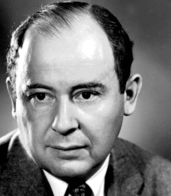
Born Janos Von Neumann in Hungary, he is known to posterity as John Von Neumann, though his friends always called him Johnny.
I give Von Neumann the first position on this list because he is the greatest mathematician on the list. The list of four great mathematicians I lectured about on the first day only takes us through to 1855, when Gauss dies. If we were listing great mathematicians since then, almost all mathematicians would put Bernhard Riemann, Henri Poincaré, David Hilbert and John Von Neumann on the list of the greatest of the great.
Not Albert Einstein. He is a great physicist, but not a great mathematician.
Von Neumann started his career in chemistry, but after he did the mathematical groundwork for the ideas of quantum mechanics, he switched to mathematics. This is some of the strangest and least intuitive mathematics ever done, and it shows that at the sub-atomic level, it is possible for some small objects to be in two places at the same time. When people would ask him how he understood some of the strange ideas he came up with in his life, Von Neumann said: "You don't really ever understand higher mathematics. You just get used to it."
Besides his work in mathematical physics, Von Neumann solved a conjecture of Borel and created the field now known as game theory. A century before, a Prussian tactician named Von Clausewitz put forward the idea of total war, that a country at war must put forward every available resource or it wasn't truly war at all. Von Neumann's game theory proved Von Clausewitz wrong, that successful war strategies include bluffs and strategic ways to put forward only part of the available resources and still meet your objectives.
Among his practical inventions include the trigger for the hydrogen bomb, which makes an atomic explosion "slow" enough that it begins a larger chain reaction instead of obliterating all matter in a radius of several hundred yards instantly. The larger chain reaction makes for an explosion thousands to millions of times stronger.
The reason Von Neumann is on this list is because he invented the idea of software. When the first computer were created, they had to be re-wired by hand every time a new problem was to be solved. There was computer memory, but it just stored data. Von Neumann put forward the idea that some of the memory hold instructions, and the computer should be hard-wired to understand these instructions. It is nearly impossible to overestimate the importance of this idea.
Von Neumann died of cancer in 1957 at the age of 53. The amount of important work he did in such a short life is as amazing as any of the great composers who died young, like Mozart or Chopin.
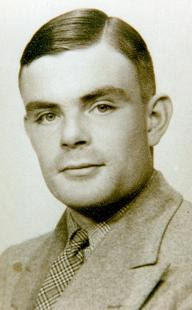
Alan Turing was born in England, and he was an excellent math student before the innovation of computers. He is given credit as one of the people who proved the Central Limit Theorem, a key fact that makes statistics work.
Turing's most famous practical work was breaking the German codes during World War II using some of the first computers ever built. The Germans had a code machine called Enigma, which could scramble a message in a way that was very difficult to unscramble without another Enigma machine at the other end AND the particular starting position of the machine when the operator began typing the message in. The British code breaking team was housed during the war at Bletchley Park, and some of the things that happened there have only been de-classified in the past ten years of so. All the information points to Turing as being the intellectual star of the team.
Turing also came up with theoretical concepts in early computers, including the Turing machine, an idealized computer with two tapes, one for input and one for output, and the Turing test for artificial intelligence.
Turing was also very openly gay at a time when that was illegal. He was charged in a court of law with engaging in homosexual acts and found guilty. He was given the option of going to jail or taking a "cure" of estrogen treatments. He chose the cure. It did nothing to change his feelings, but it did make his breasts bigger.
Turing died in 1954 at the age of 41 from eating a poison apple. He was working on electrolysis, a way of plating one metal on top of another, in this case silver plating, and absent-mindedly picked up an apple and took a bite when his hands were covered with poisonous chemicals. The authorities ruled it a suicide, though Turing's mother believed it was just an accident.
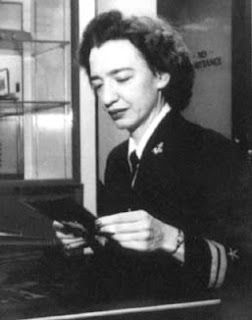
Back in the day, the actual work of programming was considered "woman's work", and many of the programmers back in the era of the huge mainframes were women, who were considered better suited to the painstaking work of making sure there were no errors in a piece of computer code. This stereotype made it possible for some women to get employment other than secretarial work in business in the middle of the century in the United States, and the stereotype continued in Japan well into the 1980's, when I was a programmer of video games in the U.S. In the era of Pac-Man and Donkey Kong, the video game designers in Japan were men, but the programmers were women.
Grace Hopper was born in New York City in 1906. She was a good math student, getting her bachelor's degree from Vassar and her doctorate at Yale. During World War II, she worked for the Navy and was on the team creating some of the first computers used by the U.S. Military, including the Mark I.
She is given credit for finding the first computer bug, which means a mistake in the program which keeps it from running properly. The bug she found was an actual bug, a moth that found its way into the computer and died when it hit the exposed wires, causing a short circuit.
Her ideas about designing a software language gave rise to COBOL, a language that was the standard for business software for many decades. Though it has been eclipsed by more modern languages, there are still listings for jobs for people who program in COBOL to this day.
She wanted to understand the connection between the speed of light and the workings of the computer that work on electricity, which moves at very close to the speed of light, so she had engineers cut pieces of wire that would show how far electricity would travel in a nanosecond, a billionth of a second, and she would hand these wires out when she gave lectures.
Hopper kept her Navy commission throughout her life, and retired with the rank of Rear Admiral.
She died in 1992 at the age of 85. She was buried with full military honors at Arlington National Cemetery. The U.S.S Hopper is one of the few ships in the Navy named after a woman, and the ship has the same nickname that the admiral had in life, Amazing Grace.
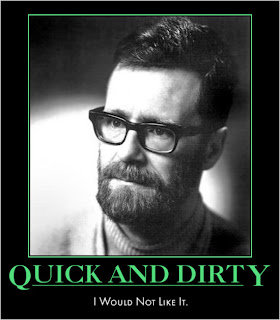
Edsger Dijkstra was born in Holland in 1930, about a generation after Hopper and Turing and Von Neumann, and his contributions to computer science dealt with changing computer programming from a haphazard practice to a well-structured and defined set of proper practices.
He started working in computers in the 1950's, and computers were still strange and exotic devices to the general public. When Dijkstra applied for his wedding license, her put "computer programmer" down as his line of work. The clerk at the registrar's office made him change it, saying that nobody programmed computers for a living. He crossed it out and wrote "theoretical physicist", which the registrar accepted as a real job people get paid for.
While Dijkstra is given credit for developing some important methods for solving problems, his main influence today is the idea that a computer program should be completely designed before anyone ever starts typing in code into a machine. There were some computer languages he felt caused people to fall into bad habits, including Grace Hopper's COBOL and other popular languages of the 1960's, including BASIC and FORTRAN. A more modern concept in programming called object oriented programming also met with his disapproval. "Object oriented programming is an exceptionally bad idea that could only have originated in California."
Another famous quote attributed to him is: "Computer Science is no more about computers than astronomy is about telescopes."
Dykstra died at the age of 72 in 2002. When asked by an interviewer what he would like to be remembered for, he replied: "If some day, someone is writing a computer program and is thinking about how to do a quick and sloppy job, and for a moment that person considers 'What would Dykstra make of this?', then decides to design the program carefully, that will be immortality enough for me."
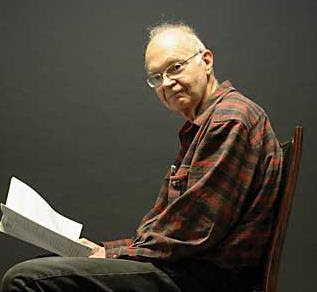
Donald Knuth was born in Wisconsin in 1938. He was a very good student and at an early age he showed how obsessed he could be with solving a problem. He skipped nearly a week from high school trying to win a national competition to find the most words that could be made using the letters in the phrase "Ziegler's Giant Bar." Knuth found 2,500 words. The second place competitor found about 600. He said he could have found more if he had realized he was allowed to use the apostrophe. The prize was a television set, which he donated to the high school.
Knuth's best known work is the textbook series The Art of Computer Programming. The first four volumes have been around since the 1970s and 1980s. The fifth volume was released only a few years back. When people send Knuth corrections to his textbooks, he send the first person who correctly spots an error a check for $2.56. The number 256 is the number of different patterns an eight bit binary string can create. Most people who get the checks frame them and hang them on their walls as souvenirs.
Donald Knuth is still alive and is professor emeritus of computer science at Stanford University. A devout Lutheran, his web page lists his public speaking engagements, and includes the Sundays when he will give a sermon as the deacon of his church on some text from the Bible.

No comments:
Post a Comment